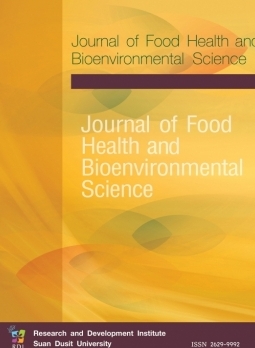Effect of Thickness on Qualities of Dried Sweet Bamboo Shoots (Dendrocalamus asper Backer) Products
Keywords:
Sweet bamboo shoots, Drying, ThicknessAbstract
The objective of this research was to investigate the effect of thickness on the quality of dried sweet bamboo shoots (SBS). The SBS were prepared with various thicknesses. The quality of dried SBS was investigated, including weight loss, lightness, hardness, and sodium chloride content. The results indicated that the weight loss and the amount of sodium chloride tended to decrease when the thickness of SBS increased. Conversely, the brightness and hardness varied directly as the thickness of SBS. The effect of thickness on drying time and rehydration time using different methods of SBS were studied. The results showed that the SBS with a thickness of 2 mm had the shortest drying time and rehydration time. The dried SBS was soaked in water at room temperature for 30 min before boiling in hot water. This method had the shortest rehydration time when compared with other methods. The sensory evaluation of dried SBS after rehydration by untrained panelists were investigated. It was found that SBS with a thickness of 2 mm had the highest scores on sensory acceptability in appearance, color, texture, flavor, and overall liking score. The analysis of the chemical composition of dried SBS was high carbohydrate (48.18%), protein (22.52%), and low-fat content (4.18%). The shelf life of dried SBS product was at least 6 months. Accordingly, the knowledge gained from this study can be applied to the production of dried SBS, which can extend the shelf life of SBS and added value of agricultural products.
References
Association of Official Analytical Chemists. (2012). Official methods of analysis (19th ed.).Washington, D.C.: Association of Official Analytical Chemists.
Azeez, M.A., & Orege, J.I. (2020). Chapter 3: Bamboo, its chemical modification and products. Retrieved January 19, 2021, from https://cdn.intechopen.com/pdfs/61253.pdf.
Bal, L.M., Kar, A., Satya, S., & Naik, S.N. (2011) Kinetics of colour change of bamboo shoot slices during microwave drying. International Journal of Food Science, 46, 827-833.
Bhattarakosol, S., & Seejan, T. (2020). Phai tong is a popular trade. Retrieved January 19, 2021, from https://www.thaikasetsart.com
Chiang Mai Rajabhat University. (2020). Bamboo. Retrieved January 19, 2021, from http://www.rspg.cmru.ac.th/activity.php?activity=3
Damondaran, S., & Parkin, K.L. (2017). Fennema's Food Chemistry. Florida: CRC Press, Taylor & Francis Group. Duncan, D.B. (1995). Multiple range and multiple f-tests, Biometrics, 11, 1-42.
Erge, H.S., Karadeniz, F., Koca, N., & Soyer, Y. (2008). Effect of heat treatment on chlorophyll degradation and color loss in green peas, GIDA, 33, 225-233.
Fellows, P.J. (2017). Food processing technology: Principle and practice. Uxbridge: Woodhead Publishing.
Huang, L., Lee, Y., Huang, B., Kuo, C., & Shaw, J. (2002). High polyphenol oxidase activity and low titratable acidity in browning bamboo tissue culture. Vitro Cellular & Developmental Biology, 38, 358-365.
Kotoki, D., & Deka, S.C. (2010). Baking loss of bread with special emphasis on increasing water holding capacity. Journal of Food Science and Technology, 47, 128-131.
Kusalaruk. W., & Limsangouan, N. (2016). Nutrition and nutraceutical of Bambusa burmanica gamble and Thysostachys siamensis gamble shoots. Thai Agricultural Research Journal, 33,169-178.
Lertwiram, P., & Sawatming, P. (2020). Use of rice bran extracts, chemical method and thermal process to delay browning in mashed potato. Retrieved January 19, 2021, from http://www.agro.cmu.ac.th/agro60/school/fst/601499/research_exercise_journal/file_upload/551310036.pdf
Madan, A., & Pare, A. (2017). Drying and rehydration behaviour of bamboo (Bambusabambos) shoots during convective tray drying. Journal of Agri Search, 1,127-134.
Ministry of public health. (2020). Announcement from the ministry of public health No. 392(2561). Retrieved January 19, 2021, from http://food.fda.moph.go.th/law/data/announ_fda/fda/No.392.pdf
Paradkar, V., & Sahu, G. (2018). Studies on drying of osmotically dehydrated apple slices. International Journal of Current Microbiology and Applied Sciences, 7, 633-642.
Rana, B., Awasthi, P., & Kumbhar, B.K. (2012). Optimization of processing conditions for cyanide content reduction in fresh bamboo shoot during NaCl treatment by response surface methodology. Journal of Food Science and Technology, 49,103-109.
Seewaeng, P., & Siriamornpun, S. (2019). Effect of drying temperature on phytochemicals and antioxidant activities of Bambusa beecheyana. Khon Kaen Agriculture Journal, 47,1385-1392.
Sirijariyawat, A., Polviluy, C., & Yalai, K. (2017). Effect of drying methods on physical property of spring onion. Khon Kaen agriculture journal, 45, 1155-1161.
Suphamityotin, P. (2013). Fruit and vegetable technology. Bangkok: Odeon store. Thai industrial standards institute. (2006). Community product standards: Dried bambooshoots (1206/2549). Retrieved January 19, 2021, from http://tcps.tisi.go.th
Yuenyongputtakal, W. (2013). Factors influencing on dewatering by osmotic dehydration of fruits and vegetables. Burapha Science Journal, 18, 226-233.
Zhang, J., Ji, R., Hu, Y., Chen, J., & Ye, X. (2011). Effect of three cooking methods on nutrient components and antioxidant capacities of bamboo shoot (Phyllostachys praecox C.D. Chu et C.S. Chao). Journal of Zheijang University Science B, 12, 752-759.
Downloads
Published
How to Cite
Issue
Section
License

This work is licensed under a Creative Commons Attribution-NonCommercial-NoDerivatives 4.0 International License.








